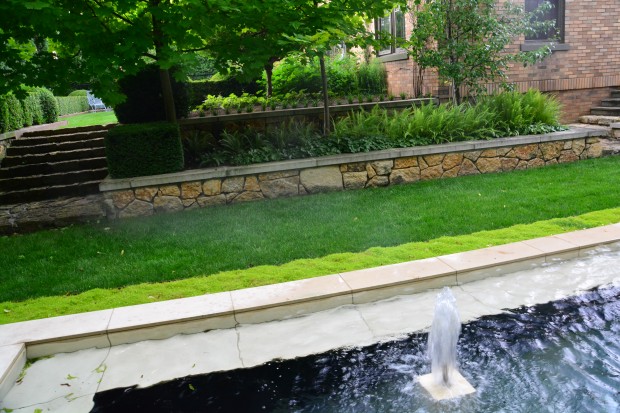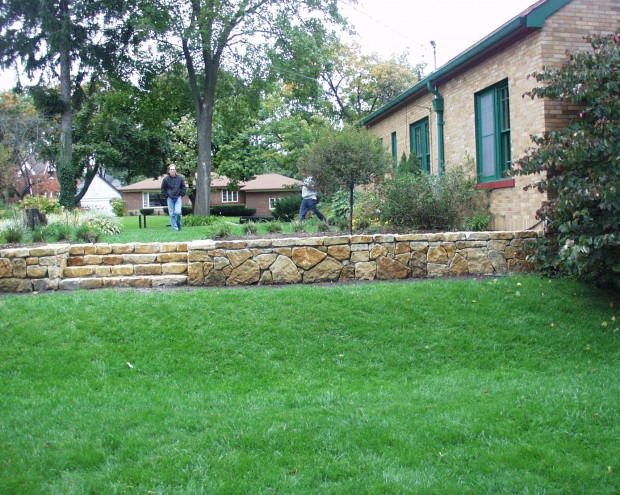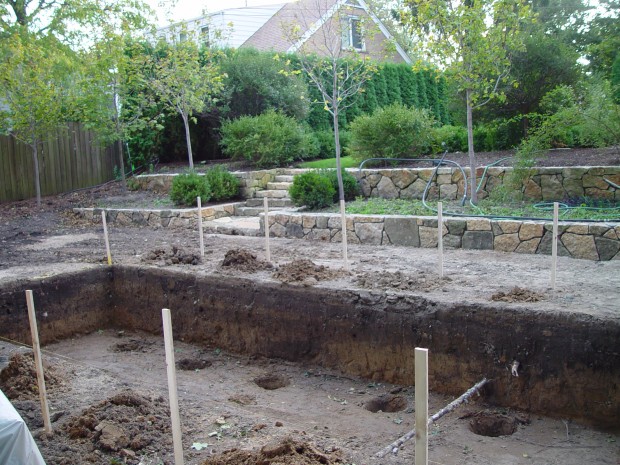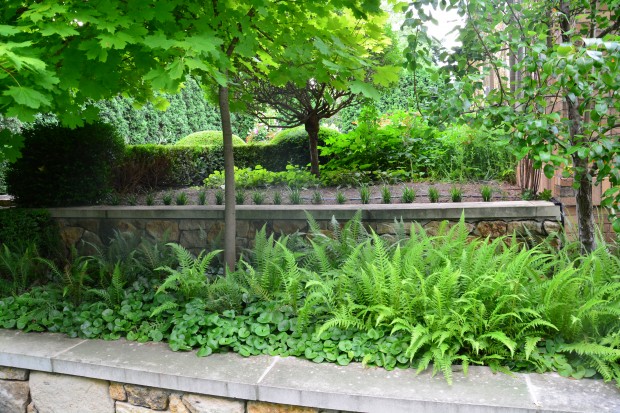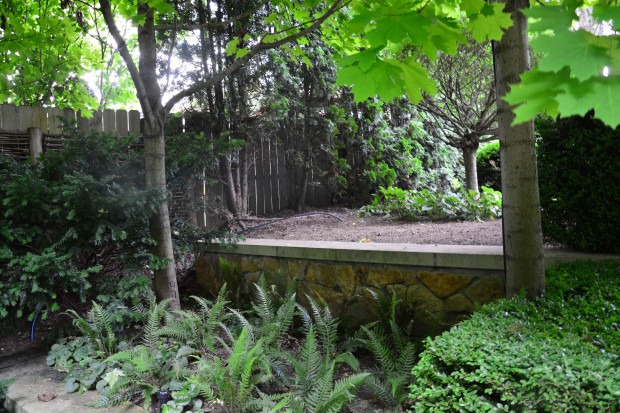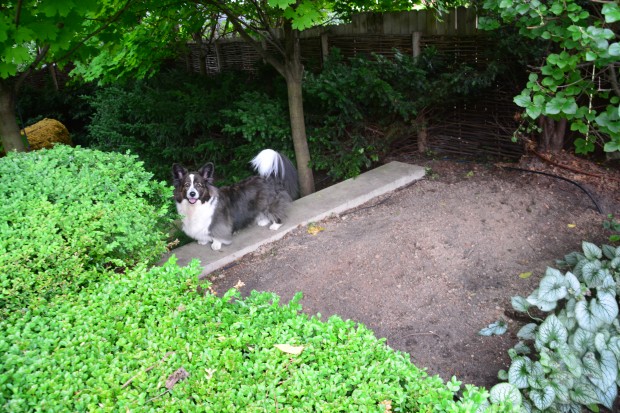 Gardeners have a complicated relationship with their gardens. The balance of power goes back and forth, much like any other serious relationship. A treasured plant/child that fails to thrive-whose fault is that? Exasperation is as prevalent as passion over a garden. A death in the garden, as in a major tree, is tumultuous, and instantly redefines that relationship – for better or for worse. Failure can hang over a garden, and thus a gardener, like a black cloud. A love for the garden can smooth over no end of resentment regarding the day to day difficult details – to a point. Gardeners and nature come face to face just about every day. The outcome is rarely a compromise. The status of most gardens is, to this gardener’s eye, more about win and loose, than a meeting of the minds. Nature bats last. I have gardened long enough to know this to be true. Poor soil conditions, light, water, and unfavorable weather can drive the most devoted gardener to the brink.
Gardeners have a complicated relationship with their gardens. The balance of power goes back and forth, much like any other serious relationship. A treasured plant/child that fails to thrive-whose fault is that? Exasperation is as prevalent as passion over a garden. A death in the garden, as in a major tree, is tumultuous, and instantly redefines that relationship – for better or for worse. Failure can hang over a garden, and thus a gardener, like a black cloud. A love for the garden can smooth over no end of resentment regarding the day to day difficult details – to a point. Gardeners and nature come face to face just about every day. The outcome is rarely a compromise. The status of most gardens is, to this gardener’s eye, more about win and loose, than a meeting of the minds. Nature bats last. I have gardened long enough to know this to be true. Poor soil conditions, light, water, and unfavorable weather can drive the most devoted gardener to the brink.
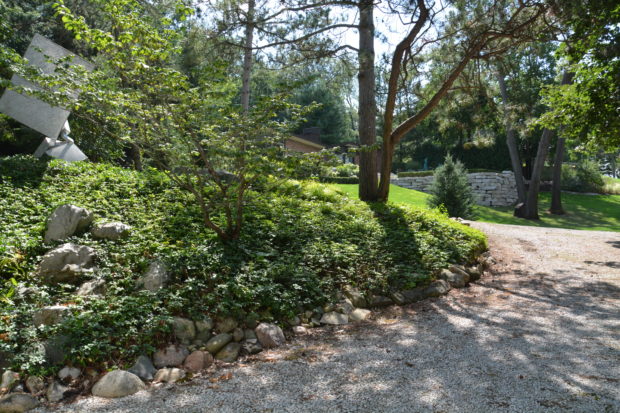 The intensely stubborn gardener who comes face to face with an overpowering, spectacularly uncaring, and uncompromising nature eventually come around and understands that nature is not a partner. It is an independent force to be reckoned with. There is no reasoning with nature. Those gardeners who believe they can negotiate a relationship with the natural forces that affect their garden have my sympathy.
The intensely stubborn gardener who comes face to face with an overpowering, spectacularly uncaring, and uncompromising nature eventually come around and understands that nature is not a partner. It is an independent force to be reckoned with. There is no reasoning with nature. Those gardeners who believe they can negotiate a relationship with the natural forces that affect their garden have my sympathy.
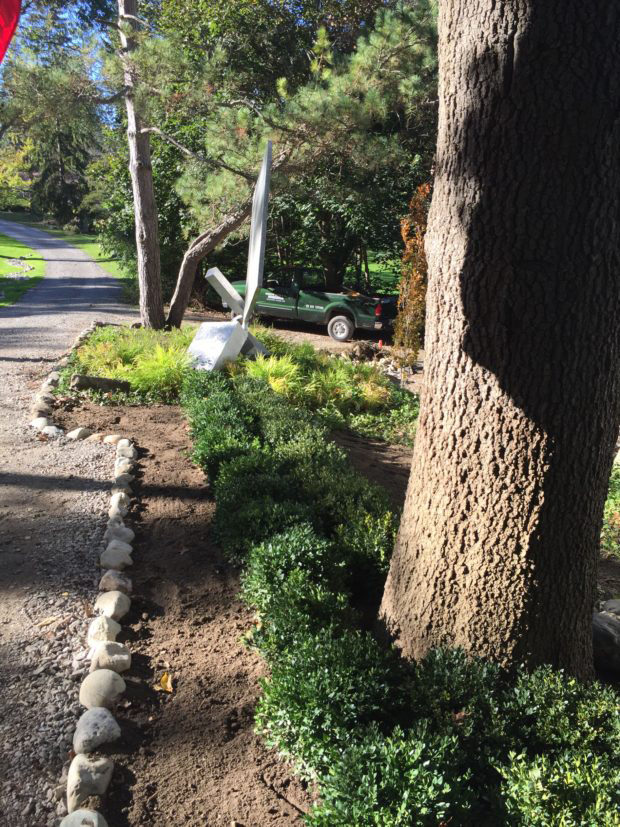 Truth be told, every gardener is on their own. Some give in. Some give up. Others ignore trouble. Still others take hold of trouble, and address it, one shovel full at a time. I know so many hands on gardeners-the work they do to keep a garden and landscape healthy and viable is amazing. I admire all of them. Some who love their landscape ask for help from me, once trouble bubbles up beyond a quick fix. Some troubles need a helping hand.
Truth be told, every gardener is on their own. Some give in. Some give up. Others ignore trouble. Still others take hold of trouble, and address it, one shovel full at a time. I know so many hands on gardeners-the work they do to keep a garden and landscape healthy and viable is amazing. I admire all of them. Some who love their landscape ask for help from me, once trouble bubbles up beyond a quick fix. Some troubles need a helping hand.
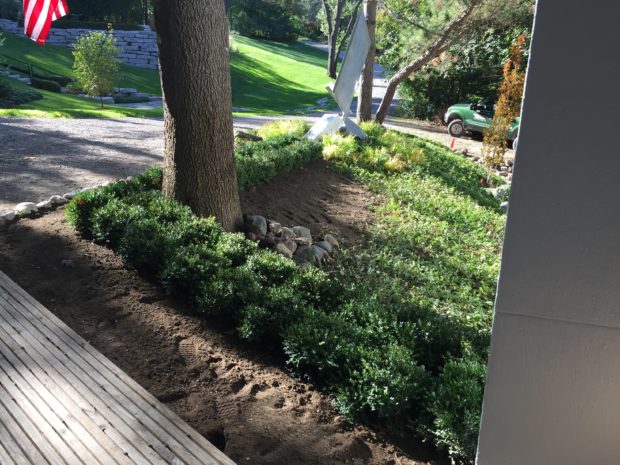 Why this essay? A client came to me in despair that his landscape on the front side of his house was beyond repair. Could I please remake it? Could I start all over again? He was happy for me to strip out everything in this steeply sloping landscape, and begin anew. My visit confirmed that a large area of ground cover had been overrun by weeds. That said, he had a king’s ransom in groundcover, well rooted in, that would not need replacing. I told him that I thought this marriage could be saved. We just needed to root out the weeds, establish crisp boundaries, restore and create a consistent grade, and add some plant material that would establish a simple and strong design. As much as I love beautiful and thriving plant material, I am in favor of good design organizing the planting. This slope is very steep. It would be difficult for me to maintain. My idea was to restore a relationship. I did not see the need for a new one.
Why this essay? A client came to me in despair that his landscape on the front side of his house was beyond repair. Could I please remake it? Could I start all over again? He was happy for me to strip out everything in this steeply sloping landscape, and begin anew. My visit confirmed that a large area of ground cover had been overrun by weeds. That said, he had a king’s ransom in groundcover, well rooted in, that would not need replacing. I told him that I thought this marriage could be saved. We just needed to root out the weeds, establish crisp boundaries, restore and create a consistent grade, and add some plant material that would establish a simple and strong design. As much as I love beautiful and thriving plant material, I am in favor of good design organizing the planting. This slope is very steep. It would be difficult for me to maintain. My idea was to restore a relationship. I did not see the need for a new one.
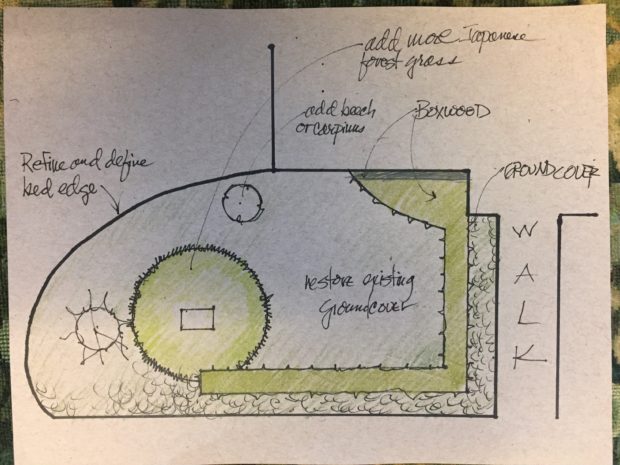 This simple sketch illustrated how I planned to make some sense of a weed infested steep slope. My client was dubious that he could restore order to his landscape. I think he was right in that regard. This restoration needed a group effort. I was sure that my group could bring this landscape around. He did like the drawing, and gave me the go ahead. The weeding part would not be overwhelming, as we had four people on that tedious problem. Our weeding process involved tools- all of my staff have their own hori-hori knife. For especially difficult weeds, we had garden forks, and spades. Our process is neither tentative nor dainty. There are times when a tough intervention is a good idea.
This simple sketch illustrated how I planned to make some sense of a weed infested steep slope. My client was dubious that he could restore order to his landscape. I think he was right in that regard. This restoration needed a group effort. I was sure that my group could bring this landscape around. He did like the drawing, and gave me the go ahead. The weeding part would not be overwhelming, as we had four people on that tedious problem. Our weeding process involved tools- all of my staff have their own hori-hori knife. For especially difficult weeds, we had garden forks, and spades. Our process is neither tentative nor dainty. There are times when a tough intervention is a good idea.
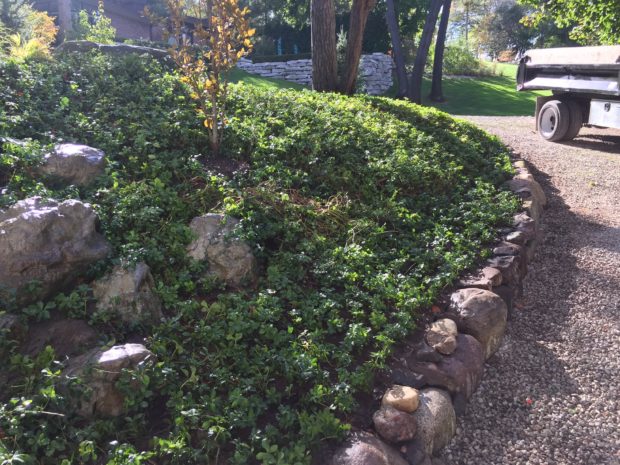 This was a marriage eminently worth saving. We removed and rebuilt all of the rock edges of this bed. A strong curve on the house side would be contrasted with a straight side rock edge on the road side. We added soil behind the new rock wall to unify the and simplify the slope from the road to the garage. A landscape bed with a deliberate shape and volume is visually satisfying. We removed a next to dead dogwood, and replaced it with a columnar beech.
This was a marriage eminently worth saving. We removed and rebuilt all of the rock edges of this bed. A strong curve on the house side would be contrasted with a straight side rock edge on the road side. We added soil behind the new rock wall to unify the and simplify the slope from the road to the garage. A landscape bed with a deliberate shape and volume is visually satisfying. We removed a next to dead dogwood, and replaced it with a columnar beech.
 I had no problem having a crew go over every square inch of this bed, and remove weeds. We filled the low spots with new soil. We grubbed out and lowered the high spots. We added more ground cover, densely planted, in the bare areas. We added boxwood to bolster the existing boxwood. We rebuilt the rock edges. We dusted the entire bed with a few inches of ground hardwood bark mulch. And we put him in touch with our irrigation contractor, with the idea of installing a low tech watering system that could deliver the water needed. The restoration was vastly more cost effective than a start from scratch approach. And vastly better looking.
I had no problem having a crew go over every square inch of this bed, and remove weeds. We filled the low spots with new soil. We grubbed out and lowered the high spots. We added more ground cover, densely planted, in the bare areas. We added boxwood to bolster the existing boxwood. We rebuilt the rock edges. We dusted the entire bed with a few inches of ground hardwood bark mulch. And we put him in touch with our irrigation contractor, with the idea of installing a low tech watering system that could deliver the water needed. The restoration was vastly more cost effective than a start from scratch approach. And vastly better looking.
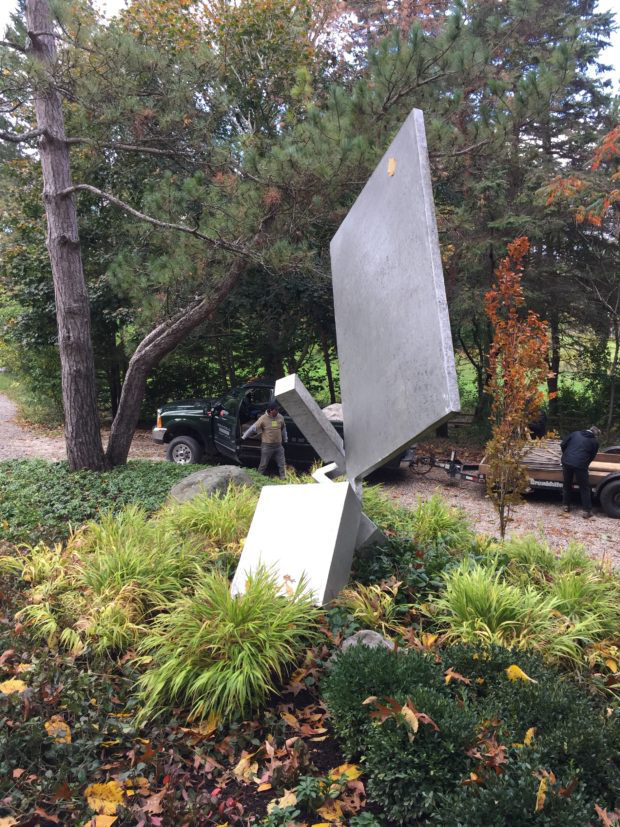 There were a number of Japanese forest grasses existing in this bed that were thriving. We replanted them in a dense circle around a treasured sculpture, and added more. The idea was to make the sculpture a more strikingly prominent feature of the landscape.
There were a number of Japanese forest grasses existing in this bed that were thriving. We replanted them in a dense circle around a treasured sculpture, and added more. The idea was to make the sculpture a more strikingly prominent feature of the landscape.
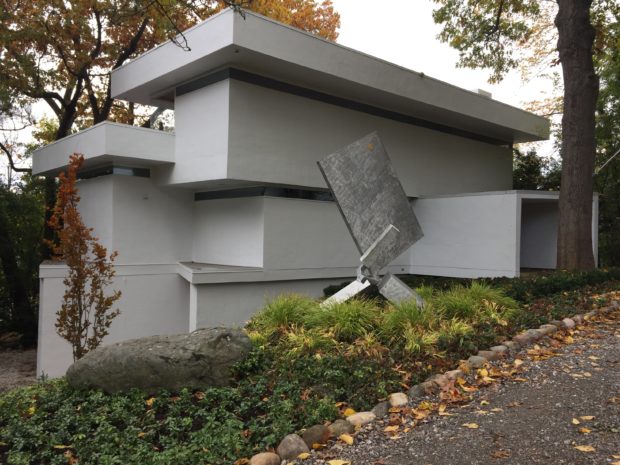 In my opinion, the outcome of this renovation is good. The revised landscape features a beautiful steel sculpture. The ground plane is simply curving, weed free, and plant covered.
In my opinion, the outcome of this renovation is good. The revised landscape features a beautiful steel sculpture. The ground plane is simply curving, weed free, and plant covered.
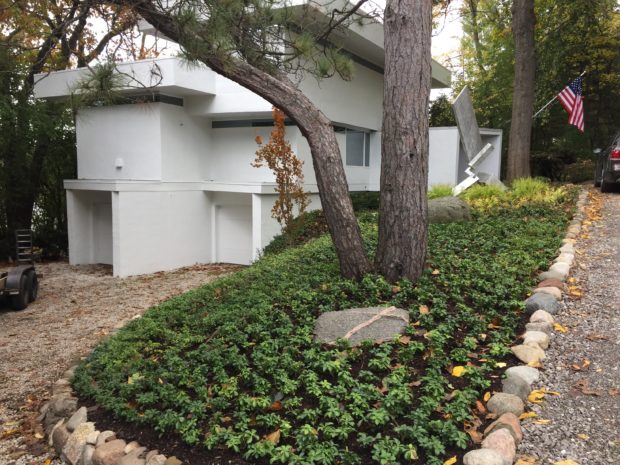 My client is pleased by the outcome of this project. I am especially pleased that we were able to save so much of what existed here. What we added was little. What we rearranged was a lot. The few additions and the considerable subtractions transformed this landscape.
My client is pleased by the outcome of this project. I am especially pleased that we were able to save so much of what existed here. What we added was little. What we rearranged was a lot. The few additions and the considerable subtractions transformed this landscape.
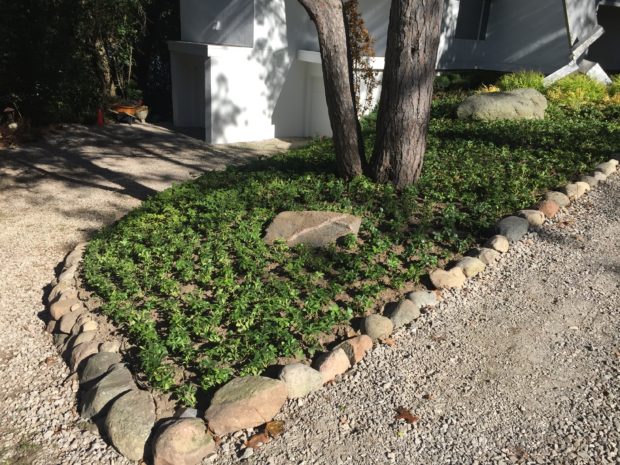 The difference between a landscape gone awry, and in sore need of some restoration, and a strikingly beautiful landscape can be not much more than a few degrees this way or that. Every garden marriage can be saved. I believe this.
The difference between a landscape gone awry, and in sore need of some restoration, and a strikingly beautiful landscape can be not much more than a few degrees this way or that. Every garden marriage can be saved. I believe this.
